notempty
Phase 1 | |||
Tab Connections Button GeneralTab General | |||
| Caption | Value | Description | 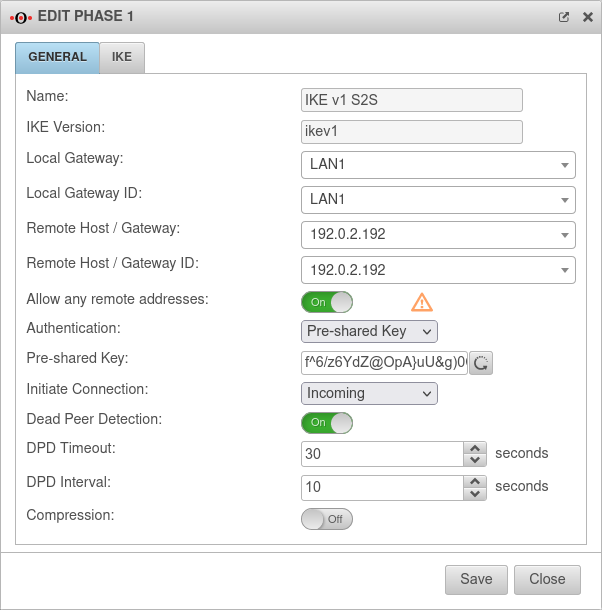 |
|---|---|---|---|
| Allow any remote addresses: | On Default |
Disable this option for site-to-site connections with DynDNS hosts if multiple IPsec connections with a priori unknown addresses (DynDNS S2S, Roadwarrior) are configured. | |
| Initiate Connection: | The tunnel is initiated by the UTM even if no packets are sent. Incoming requests are accepted. | ||
| The UTM accepts incoming tunnel requests. No outgoing connection is created. | |||
| The tunnel is initiated by the UTM only when packets are to be sent. | |||
| Deactivates the tunnel | |||
| Dead Peer Detection: | On | Checks at a set interval whether the tunnel still exists. If the tunnel was terminated unexpectedly, the SAs are dismantled. (Only then it is also possible to reestablish a new tunnel). | |
| DPD Timeout: Only with IKEv1 New as of 12.2.3 |
30 seconds | Period before the state under Startup behavior is restored. The same values are used here as for regular packets. | |
| DPD Interval: New as of 12.2.3 |
10 seconds | Testing interval | |
| Compression: | Off | Compression is not supported by all remote stations | |
Tab IKE Settings that must be identical in the UTM and in the client: IKE | |||
| Caption | Default-Werte UTM | Default-Werte NCP-Client | 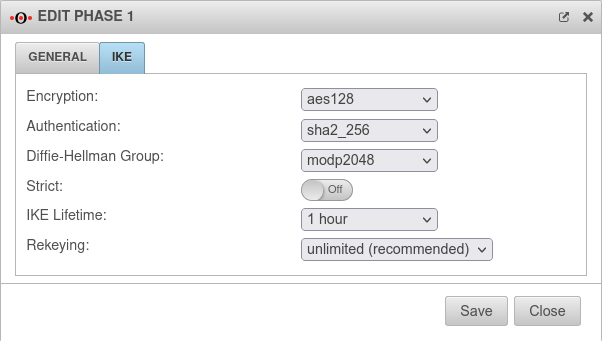 |
| Encryption: | AES 128 Bit | ||
| Authentication: | Hash: SHA2 256 Bit | ||
| Diffie-Hellman Group: | IKE DH-Grupe: DH2 (modp1024) | ||
| Tab IKE More settings: | |||
| Caption | Value | Description | |
| Strict: | Off | The configured parameters (authentication and encryption algorithms) are preferred for connections | |
| On | No further proposals are accepted. A connection is only possible with the configured parameters. | ||
| IKE Life time: | Validity period of the Security Association: Agreement between two communicating entities in computer networks. It describes how the two parties apply security services to communicate securely with each other. When using multiple services, multiple security connections must also be established. (Source: Wikipedia 2022) in phase 1 | ||
| Rekeying: | Number of attempts to establish the connection (initial or after abort). For E2S connections (Roadwarrior), the setting 3 times can avoid endless attempts to connect to devices that are not correctly logged out. | ||
Phase 2 | |||
Tab Connections Button GeneralTab General : Settings that must be identical in the UTM and in the client: | |||
| Caption | Default-Werte UTM | Default-Werte NCP-Client | 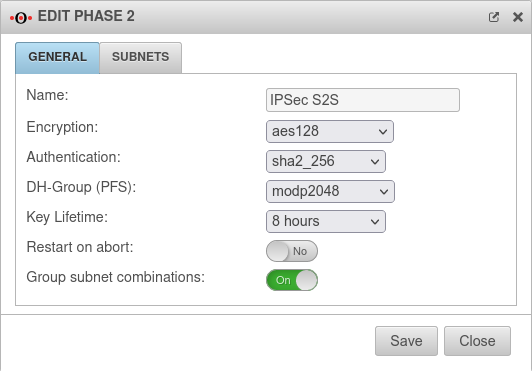 |
| Encryption: | AES 128 Bit | ||
| Authentication: | SHA2 256 Bit | ||
| DH-Gruppe (PFS): | keine | ||
| Schlüssel-Lebensdauer: | Validity period of the key in phase 2 | ||
| Austausch-Modus | Main Mode (nicht konfigurierbar) | Aggressive Mode (IKEv1) The UTM does not support Aggressive Mode for security reasons. | |
Tab General: More settings | |||
| Caption | Value | Description | |
| Restart after abort: | No | If the connection was terminated unexpectedly, activating will restore the state configured under Startup behavior in phase 1. | |
| Group subnet combinations: Only with IKEv2 |
Yes |
If more than one network is configured on the local side or at the remote gateway, a separate SA is negotiated for each subnet combination when it is deactivated. This results in numerous subnet combinations and thus many SAs, especially with multiple subnets, and leads to limitations and losses in the stability of the connections due to the design of the IPSec protocol. | |
SubnetsTab Subnets Only with IKEv2 | |||
| Scenario: All subnets have access to each other
With an SSH login as root, the behavior can be understood particularly well.
|
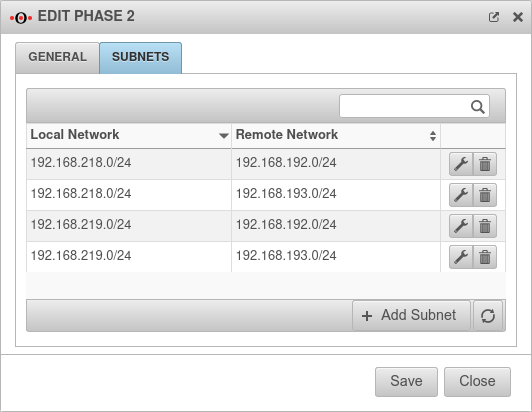 | ||
| Scenario: Not all subnets may access every network of the remote gateway
If in phase two a local network is not connected to all remote networks (or a remote network is not connected to all local ones), this will not be taken into account if the option Group subnet combinations is active! The Group subnet combinations option will connect all local networks to all remote networks!
Port filter rules make it possible to control access.
With an SSH login as root, the behavior can be understood particularly well.
|
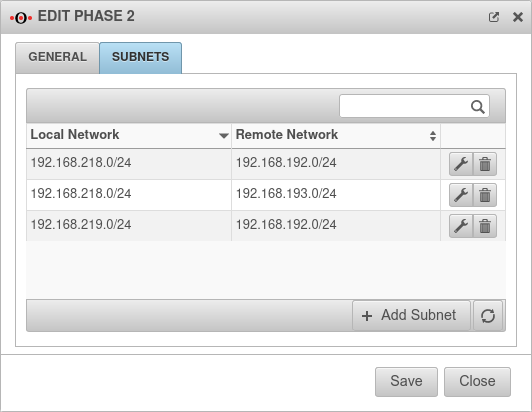 | ||
TroubleshootingDetailed Troubleshooting instructions can be found in the Troubleshooting Guide If an email address should be used as gateway ID, it is necessary to insert a double @@ in front of the ID (mail@... becomes @@mail@...). Otherwise the ID will be treated as FQDN
| |||